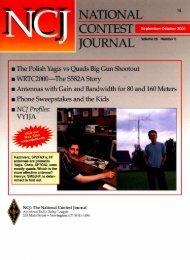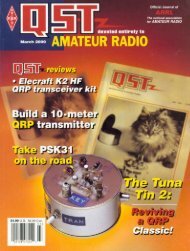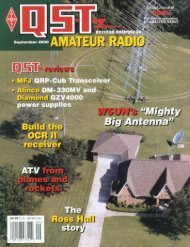the software, PSK31 tuning required practice.You had to learn to recognize the sightand sound of your target signal. With theweak warbling of PSK31, that wasn’t alwayseasy to do. And if your radio didn’t tune in1-Hz increments, the receiving task becameeven more difficult.Nick Fedoseev, UT2UZ, and Skip Teller,KH6TY, designed a solution and called itDigiPan. The “pan” in DigiPan stands for“panoramic”—a complete departure fromthe way most PSK31 programs work. WithDigiPan the idea is to eliminate tedioustuning by detecting and displaying not justone signal, but entire groups of signals.If you are operating your transceiver inSSB without using narrow IF or audio-frequencyfiltering, the bandwidth of the receiveaudio that you’re dumping to yoursound card is about <strong>2000</strong> to 3000 Hz. Witha bandwidth of only about 31 Hz, a lot ofPSK31 signals can squeeze into that spectrum.DigiPan acts like an audio spectrumanalyzer, sweeping through the receivedaudio from 100 to 3000 Hz and showingyou the results in a large waterfall displaythat continuously scrolls from top to bottom.What you see on your monitor are verticallines of various colors that indicateevery signal that DigiPan can detect. Brightyellow lines represent strong signals whileblue lines indicate weaker signals.The beauty of DigiPan is that you donot have to tune your radio to monitor anyof the signals you see in the waterfall. Yousimply move your mouse cursor to the signalof your choice and click. A black diamondappears on the trace and DigiPanbegins displaying text. You can hop fromone signal to another in a heartbeat merelyby clicking your mouse! If you discoversomeone calling CQ and you want to answer,click on the transmit button and awayyou go—no radio adjustments necessary.(And like the original PSK31 software,DigiPan automatically corrects for frequencydrift.)Even I can Master DigiPanMost of the PSK31 signals on 20 metersare clustered around 14.070 MHz, so I justpark my rig in the vicinity and boot upDigiPan. I can opt to display the audio frequencieson the DigiPan waterfall, or I canenter the frequency displayed on my radio’sVFO and DigiPan will indicate correspondingRF frequencies.One remarkable aspect of DigiPan isthat it allows you to see (and often copy)PSK31 signals that you cannot otherwisehear. It is not at all uncommon to see severalstrong signals (the audible ones) interspersedwith wispy blue ghosts of veryweak “silent” signals. I’ve clicked on a fewof these ghosts and have been rewardedwith text (not error free, but good enough44 <strong>May</strong> <strong>2000</strong>to understand what is being discussed).Using DigiPan reminds me of the sonaroperators in the movie The Hunt for RedOctober. There is an eerie excitement infinding one of those ghostly traces and mutteringto yourself, “Hmmm...what do wehave here? An enemy submarine rigged forsilent running? A distant pod of killerwhales? Or Charlie in Sacramento running5 W to his attic dipole?”DigiPan is, in my opinion, one of themost important developments in the briefhistory of PSK31. It makes this excitingmode more “user friendly” and accessibleto a larger audience and a larger assortmentof radios (the ability to tune in 1-Hz stepsisn’t a requirement for DigiPan). And Ihaven’t even mentioned DigiPan’s otherfeatures such as a type-head buffer, loggingfunctions, macros and much more. You candownload DigiPan on the Web at http://members.home.com/hteller/digipan/.Note that you need a 486-100 PC or fasterrunning Windows 95 or 98.PSK31 on the AirAs I’ve already mentioned, 14.070 MHz(+/– 2 kHz) seems to be the hot hangout forPSK31. Activity is gradually spreading toother bands, too. When 10 meters is open listenfor warbles around 28.120 MHz. PSK31operators also haunt 10.140 MHz on occasion.Last winter I heard some PSK31 actionclustered around 3.580 and 3.610 MHz.It’s fair to say that PSK31 signals nowoutnumber Baudot RTTY for casual QSOs,but RTTY is still the king of contests. EvenThere is plenty of DX on PSK31! 5N0ZKDhas been active on several bands.so, the PSK31 contests sponsored by theTroy Amateur Radio Association (TARA)and the Chautauqua County Contest Club(CCCC) have attracted a surprising amountof activity. Look for more of these to popup in “Contest Corral.”RTTY is still dominant in the digital DXworld, but that picture is changing rapidly.A number of DXpeditions have usedPSK31 and more have announced their intentionto be “warbling” from exotic locationsthis year.Has anyone worked 100 DXCC countrieson PSK31? I’ve heard of a few allegedclaims passed along the grapevine, but nothingverified—yet. The PSK31 DX is outthere. Even with my half-hearted attemptsat chasing DX I’ve managed to net about 30countries. Some of my catches have included5N0ZKD, TF3VS and 4Z5AO.PSK31 activities have not been confinedto the HF bands. Andy Bachler, N9AB, hastried PSK31 moonbounce experiments withlimited success. (Unfortunately the phasedistortion wreaks havoc with the PSK31signal.) Others have established experimentalPSK31 beacons on 6 meters, 2 metersand 70 cm. Some hams are even usingPSK31 on 2-meter FM as a kind of educationaltool to inspire their local brethren toexpand their horizons.The FutureI don’t think it is a coincidence that manynew PSK31 users are running low power,often with indoor antennas. Since PSK31 hassuch excellent weak-signal performance,hams who’ve been off the air because of antennarestrictions or RFI problems (or both!)are now finding a new way to enjoy thehobby once again. It’s common to read:“Running 20 W to an indoor dipole…”Amateurs who enjoy low-power QRPoperating for the sake of QRP itself are alsofinding excitement in PSK31. Although itis certainly feasible to operate QRP phone,the tradition has been to use CW for greatestefficiency. Now PSK31 offers a newQRP mode that rivals CW’s performance.Hams are buying used Pentium laptops(with sound capability) and taking them tothe great outdoors to run PSK31 with QRPSSB rigs. My guess is that you’ll hear morethan a few PSK31 signals next month duringField Day.PSK31 was in the right place at the righttime. Amateur Radio was in need of ajumpstart in 1999, something to bringpeople back on the air and help restore thelong-lost sense of wonder. Because the majorityof amateurs already owned computerswith sound cards, their “risk” and investmentin PSK31 was essentially zero. Allthey had to do was download the softwareand fashion a couple of cables. If they triedPSK31 and didn’t like it, little was lost.
“My PSK31 Doesn’t Work!”We’ve had a year to accumulate the various trouble reports andcures. Here are several of the most common problems and solutions.Problem: I know I’m getting receive audio from my radio to mysound card. I can even hear my radio’s audio in my computer speakers.The PSK31 software, however, is dead as a doornail. There isnothing whatsoever in the tuning display.Solution: Your receive audio is indeed reaching your computer,but it is not reaching the PSK31 software. This is a common glitch inWindows 95 and 98 and it involves misadjustment of the sound cardmixer. Follow these steps:1. Double click on the little loudspeaker in the lower right cornerof your Windows screen.2. The Volume Control panel should appear. Click on Options,then Properties.3. In the “Adjust volume for…” section, click on the circlelabeled Recording, then click OK.4. The mixer panel you see now is the Recording Control. Clickon the little box to select Line-In, then move the slider all the way up.Note that some programs may disable this setting. Don’t be surprisedif you have to repeat these steps after running certain types ofsoftware.Problem: People keep telling me that they are hearingstrange noises on my PSK31 signal.Solution: This is another common woe—and it is easy to fix. Thestrange noises are the cute little boops and beeps that you’ve askedWindows to play when you open a program, close a window and so on.The straightforward cure is to avoid opening windows or taking otheractions that generate cute sounds while you are transmitting. You canalso turn the offending sounds off by going to Settings, Control Paneland clicking on the Sounds icon. This will allow you to scroll throughthe list of sounds you’ve chosen. By changing the selection to “None”for a particular sound, you are effectively turning it off.Problem: I’m told that people can hear my voice and othernoises in the room when I am transmitting.Solution: Unplug your microphone. You’re feeding your PSK31signal to the accessory jack on your transceiver and probably keyingit that way as well. The problem is that your radio is still acceptingaudio from your microphone jack, too. When you key the radio totransmit PSK31, your microphone is live!Problem: Stations report that my PSK31 signal looks fuzzy ontheir waterfall displays.Solution: When your PSK31 station is idling (not sending data),stations should see your signal as two distinct lines, possibly with abit of fuzziness between. When you start typing, the lines should lookas though they are segmented or twisted together. A PSK31 signalthat looks like a solid fuzzy line often indicates the presence of distortion.RF may be getting into your sound card, the sound card maybe overdriven, or you could be picking up hum induced by groundloops. Try reducing output and see if that cures the problem. If not,consider using a couple of isolation transformers in the cables betweenthe sound card and your radio.Figure B—A simple circuit for keying transceivers fromcomputer COM ports.Figure C—The new RIGblaster sound card interface.Problem: The PSK31 software doesn’t key my radio to transmit.Solution: Most hams are using some variation of the circuitshown in Figure B to key their radios from their computer COMports. If this applies to you, don’t forget that some PSK31 programsactivate the COM port DTR or RTS pins—but not both. (The originalG3PLX software sends logic “highs” to both pins.) If you have yourkeying interface tied to the DTR (or RTS) pin, try switching it tothe other pin. A more elegant solution to sound-card interfacingand keying is now available in the form of the RIGblaster fromWest Mountain Radio, 18 Sheehan Ave, Norwalk, CT 06854; tel203-853-8080; K1UHF@westmountainradio.com; http://www.westmountainradio.com. This neat little box (see Figure C) takescare of transceiver keying, microphone switching, audio level matchingand so on.—WB8IMYIf the increasing number of signals isany indication, hams are trying PSK31 andsticking with it. They are also discoveringthat with different sound-card software theycan use their PSK31 hookups to run Slow-Scan Television, RTTY and more. There isa small revolution going on and it’s refreshingto witness. Anything that invigoratesAmateur Radio is nourishment for our future.To quote Inspector Kemp in the movieYoung Frankenstein, “A riot is an ugly thing...and it’s about time we had one!”You can contact the author at 225 Main St,Newington, CT 06111; sford@arrl.org.FEEDBACK◊ Please refer to Dwayne Kincaid,WD8OYG, “A Repeater Controller Accessory:The RCA,” <strong>QST</strong>, Feb <strong>2000</strong>, p 44,Figure 7. Add a center tap connection tothe secondary (bifilar) winding of T1, connectingthe other end of the center tap tothe junction of C1, R6 and C4. To the descriptorof T1 add the words “center tap.”—tnx GJ3RAX and W1VT◊ Please refer to Wayne J. Stanley,W4RDG, “A Simple Meter Tester,” <strong>QST</strong>,Mar <strong>2000</strong>, pp 41-42. Author Stanley offersanother approach to avoiding battery drainas identified in endnote 3. Relocate the momentarypush-button TEST switch betweenthe 9-V battery and regulator (U1) inputpin, then connect the regulator output pindirectly to the junction of R12 and R9. Also,the push-button TEST switch should belabeled S1, not S2.—tnx Wayne J. Stanley,W4RDG◊ The Web address of Twenty First CenturyBooks shown in our review of Nikola Tesla;Guided Weapons and Computer Technology(March <strong>2000</strong> <strong>QST</strong>, page 112) is incorrect.The correct address is: http://www.tfcbooks.com/.<strong>May</strong> <strong>2000</strong> 45
- Page 6 and 7: May 2000 Volume 84 Number 5David S
- Page 11 and 12: THE AMERICAN RADIORELAY LEAGUE INC
- Page 14: Get to Know Your Section ManagerThe
- Page 18: The ARRL and the FCC’s Private Wi
- Page 22 and 23: The postman always keys twice.Accor
- Page 26 and 27: CORRESPONDENCEYour opinions count!
- Page 30 and 31: By Ian Poole, G3YWXOperating in the
- Page 32 and 33: By Roger Sullivan, WA0ETE, and Hugh
- Page 34 and 35: By Jim Graver, KB8PSO2000Dayton Ham
- Page 36 and 37: Figure 1A—Schematic of the interf
- Page 38 and 39: All input/output connections are ma
- Page 40 and 41: Figure 4—Hanger loopconstruction.
- Page 42 and 43: Figure 2—A GOES-8 picture capture
- Page 44 and 45: By Steve Ford, WB8IMYPSK31 2000In e
- Page 48 and 49: WORKBENCHPROJECTS AND INFORMATION F
- Page 50 and 51: By Martin A. Minow, K6MAMPractice M
- Page 52 and 53: the download to a suitable location
- Page 54 and 55: 52 May 2000SHORT TAKESHeil Sound Go
- Page 56 and 57: By Zack Lau, W1VTA No-Tune 2-Meter
- Page 58 and 59: HINTS & KINKSA FOLD-DOWN MOBILE-ANT
- Page 60 and 61: By James Kates, N9GBBConfessions of
- Page 62 and 63: PRODUCT REVIEWKenwood TM-D700A Dual
- Page 64 and 65: is accomplished by using OK, BACK a
- Page 66 and 67: other radio operation. The chatter
- Page 68 and 69: operation because there’s so litt
- Page 70 and 71: consideration in the WT Docket 98-1
- Page 72 and 73: News in Brief:• League members no
- Page 74 and 75: communications tests in celebration
- Page 76 and 77: I’ve done this tour several years
- Page 78 and 79: The Crystal Symphony at anchor off
- Page 80 and 81: Table 1Claimed North American Dista
- Page 82 and 83: Okay in My LogBy Vic Curtis,WA3YUVP
- Page 84 and 85: their 432 MHz triumph of the previo
- Page 86 and 87: 2000 ARRL Field DayRulesBy Dan Hend
- Page 88 and 89: Collecting Vintage QSLsOLD RADIOAn
- Page 90 and 91: DIGITAL DIMENSIONAPRS Digipeater in
- Page 92 and 93: AT THE FOUNDATIONWhy We Fund Museum
- Page 94 and 95: It is with deep regret that we reco
- Page 96 and 97:
COMING CONVENTIONSARRL NATIONAL CON
- Page 98 and 99:
checking; handicapped accessible; f
- Page 106:
of the West Allis ARC and served as
- Page 110:
introduced that could of had a bear
- Page 114:
211/109; NJN/L 29/203/103; CJTN 29/
- Page 118:
W1PEX 1048, WA1JVV 143, N1NH 105, W
- Page 124:
an activity we enjoy so much can be
- Page 128:
126He is President of the Amateur R
- Page 132:
is Walt Bacon, N6SMT, who is curren
- Page 150:
Ham Adsl) Advertising must pertain
- Page 154:
BAHAMAS RENTAL: Abaco villa w/stati
- Page 164:
“EVERYTHING FOR THE MORSE ENTHUSI
- Page 168:
TUBES WANTED: Highest prices paid o
















